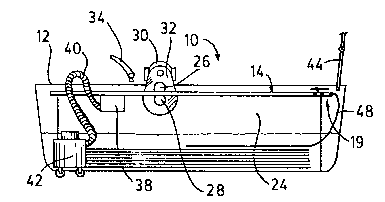Some of the information on this Web page has been provided by external sources. The Government of Canada is not responsible for the accuracy, reliability or currency of the information supplied by external sources. Users wishing to rely upon this information should consult directly with the source of the information. Content provided by external sources is not subject to official languages, privacy and accessibility requirements.
Any discrepancies in the text and image of the Claims and Abstract are due to differing posting times. Text of the Claims and Abstract are posted:
| (12) Patent Application: | (11) CA 2046142 |
|---|---|
| (54) English Title: | VERTICAL BLIND CLEANER |
| (54) French Title: | NETTOYANT POUR STORES VENITIENS |
| Status: | Deemed Abandoned and Beyond the Period of Reinstatement - Pending Response to Notice of Disregarded Communication |
| (51) International Patent Classification (IPC): |
|
|---|---|
| (72) Inventors : |
|
| (73) Owners : |
|
| (71) Applicants : |
|
| (74) Agent: | ADE & COMPANY |
| (74) Associate agent: | |
| (45) Issued: | |
| (22) Filed Date: | 1991-07-03 |
| (41) Open to Public Inspection: | 1992-01-07 |
| Availability of licence: | N/A |
| Dedicated to the Public: | N/A |
| (25) Language of filing: | English |
| Patent Cooperation Treaty (PCT): | No |
|---|
| (30) Application Priority Data: | ||||||
|---|---|---|---|---|---|---|
|
-7-
VERTICAL BLIND CLEANER
ABSTRACT
The fabric strips of vertical blinds are cleaned using a novel method of
apparatus. A strip is laid on an elongate tray and wetted with an appropriate washing
liquid, e.g. a detergent solution. The strip is then passed along the tray between two
counter-rotating brushes which act to scrub the opposite surfaces of the strip. Downstream
of the brushes, the strip is sprayed with a rinse liquid. It then travels over a perforated
section of the tray where it is subjected to a low pressure from below by a vacuum box
communicating with a wet-dry vacuum. The cleaned, partially dry strips can then be hung
to complete drying.
Note: Claims are shown in the official language in which they were submitted.
Note: Descriptions are shown in the official language in which they were submitted.

2024-08-01:As part of the Next Generation Patents (NGP) transition, the Canadian Patents Database (CPD) now contains a more detailed Event History, which replicates the Event Log of our new back-office solution.
Please note that "Inactive:" events refers to events no longer in use in our new back-office solution.
For a clearer understanding of the status of the application/patent presented on this page, the site Disclaimer , as well as the definitions for Patent , Event History , Maintenance Fee and Payment History should be consulted.
| Description | Date |
|---|---|
| Inactive: IPC from MCD | 2006-03-11 |
| Time Limit for Reversal Expired | 1996-01-03 |
| Application Not Reinstated by Deadline | 1996-01-03 |
| Deemed Abandoned - Failure to Respond to Maintenance Fee Notice | 1995-07-03 |
| Inactive: Adhoc Request Documented | 1995-07-03 |
| Application Published (Open to Public Inspection) | 1992-01-07 |
| Abandonment Date | Reason | Reinstatement Date |
|---|---|---|
| 1995-07-03 |
Note: Records showing the ownership history in alphabetical order.
| Current Owners on Record |
|---|
| TESSIER HOLDINGS LTD. |
| Past Owners on Record |
|---|
| OMER TESSIER |